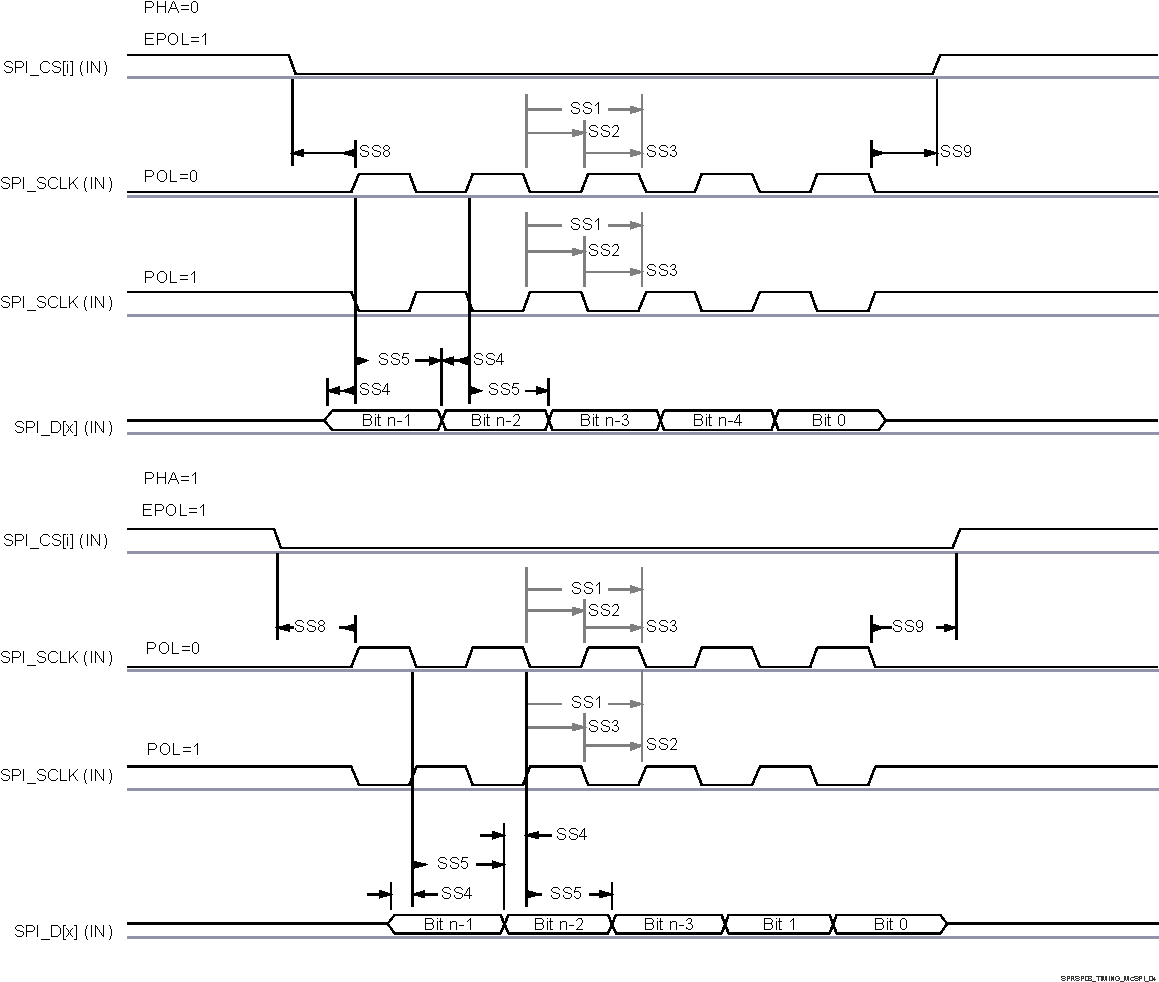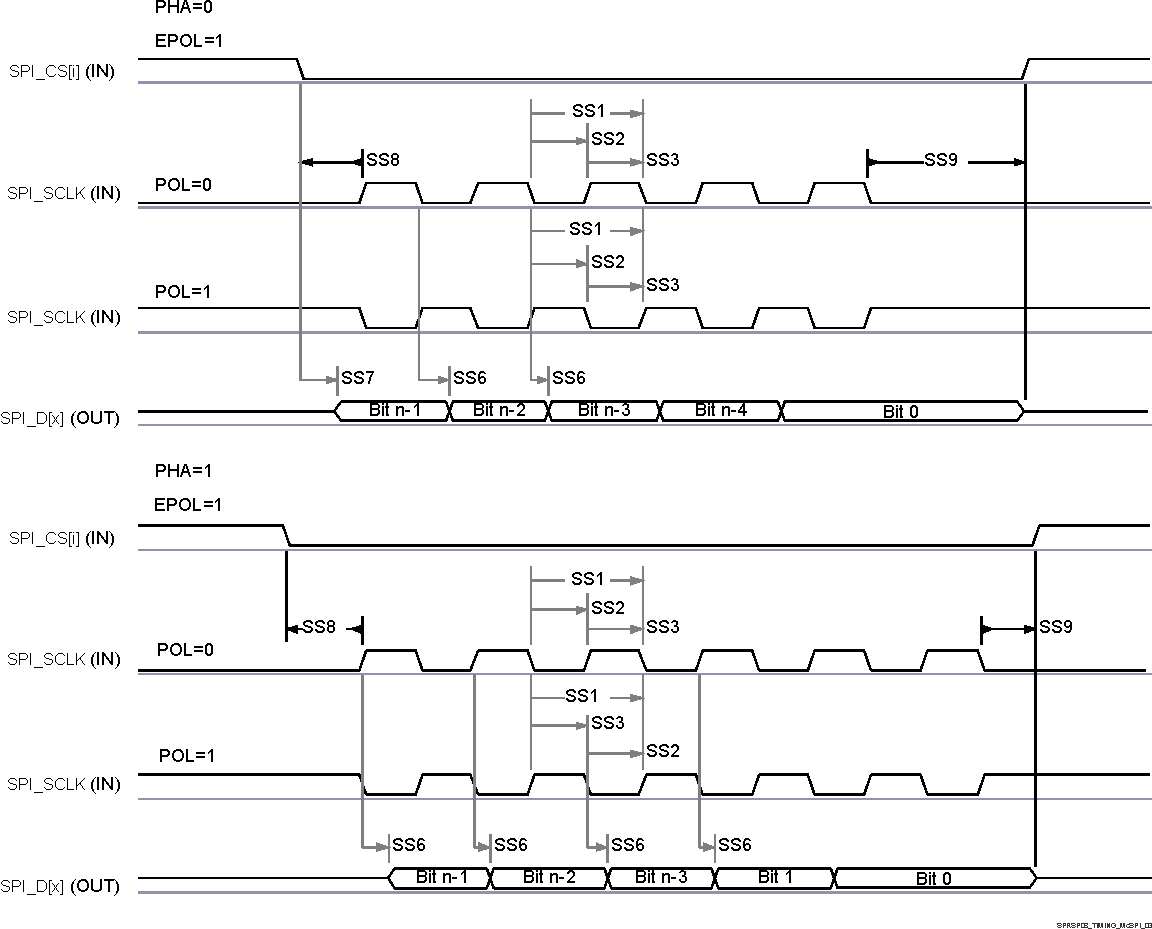SPRSP62B December 2022 – December 2024 TDA4AL-Q1 , TDA4VE-Q1 , TDA4VL-Q1
PRODUCTION DATA
- 1
- 1 Features
- 2 Applications
- 3 Description
- 4 Device Comparison
-
5 Terminal Configuration and Functions
- 5.1 Pin Diagrams
- 5.2 Pin Attributes
- 5.3
Signal Descriptions
- 13
- 5.3.1 ADC
- 5.3.2 DDRSS
- 5.3.3 GPIO
- 5.3.4 I2C
- 5.3.5 I3C
- 5.3.6 MCAN
- 5.3.7 MCSPI
- 5.3.8 UART
- 5.3.9 MDIO
- 5.3.10 CPSW2G
- 5.3.11 ECAP
- 5.3.12 EQEP
- 5.3.13 EPWM
- 5.3.14 USB
- 5.3.15 Display Port
- 5.3.16 Hyperlink
- 5.3.17 PCIE
- 5.3.18 SERDES
- 5.3.19 DSI
- 5.3.20 CSI
- 5.3.21 MCASP
- 5.3.22 DMTIMER
- 5.3.23 CPTS
- 5.3.24 DSS
- 5.3.25 GPMC
- 5.3.26 MMC
- 5.3.27 OSPI
- 5.3.28 Hyperbus
- 5.3.29 Emulation and Debug
- 5.3.30 System and Miscellaneous
- 5.3.31 Power
- 5.4 Connection for Unused Pins
-
6 Specifications
- 6.1 Absolute Maximum Ratings
- 6.2 ESD Ratings
- 6.3 Recommended Operating Conditions
- 6.4 Power-On-Hour (POH) Limits
- 6.5 Operating Performance Points
- 6.6
Electrical Characteristics
- 6.6.1 I2C, Open-Drain, Fail-Safe (I2C OD FS) Electrical Characteristics
- 6.6.2 Fail-Safe Reset (FS Reset) Electrical Characteristics
- 6.6.3 HFOSC/LFOSC Electrical Characteristics
- 6.6.4 eMMCPHY Electrical Characteristics
- 6.6.5 SDIO Electrical Characteristics
- 6.6.6 CSI2/DSI D-PHY Electrical Characteristics
- 6.6.7 ADC12B Electrical Characteristics
- 6.6.8 LVCMOS Electrical Characteristics
- 6.6.9 USB2PHY Electrical Characteristics
- 6.6.10 SerDes 2-L-PHY/4-L-PHY Electrical Characteristics
- 6.6.11 UFS M-PHY Electrical Characteristics
- 6.6.12 eDP/DP AUX-PHY Electrical Characteristics
- 6.6.13 DDR0 Electrical Characteristics
- 6.7 VPP Specifications for One-Time Programmable (OTP) eFuses
- 6.8 Thermal Resistance Characteristics
- 6.9 Temperature Sensor Characteristics
- 6.10
Timing and Switching Characteristics
- 6.10.1 Timing Parameters and Information
- 6.10.2
Power Supply Sequencing
- 6.10.2.1 Power Supply Slew Rate Requirement
- 6.10.2.2 Combined MCU and Main Domains Power- Up Sequencing
- 6.10.2.3 Combined MCU and Main Domains Power- Down Sequencing
- 6.10.2.4 Isolated MCU and Main Domains Power- Up Sequencing
- 6.10.2.5 Isolated MCU and Main Domains Power- Down Sequencing
- 6.10.2.6 Independent MCU and Main Domains, Entry and Exit of MCU Only Sequencing
- 6.10.2.7 Independent MCU and Main Domains, Entry and Exit of DDR Retention State
- 6.10.2.8 Independent MCU and Main Domains, Entry and Exit of GPIO Retention Sequencing
- 6.10.3 System Timing
- 6.10.4
Clock Specifications
- 6.10.4.1 Input and Output Clocks / Oscillators
- 6.10.4.2 Output Clocks
- 6.10.4.3 PLLs
- 6.10.4.4 Module and Peripheral Clocks Frequencies
- 6.10.5
Peripherals
- 6.10.5.1 ATL
- 6.10.5.2
CPSW2G
- 6.10.5.2.1 CPSW2G MDIO Interface Timings
- 6.10.5.2.2 CPSW2G RMII Timings
- 6.10.5.2.3
CPSW2G RGMII Timings
- 6.10.5.2.3.1 RGMII[x]_RXC Timing Requirements – RGMII Mode
- 6.10.5.2.3.2 CPSW2G Timing Requirements for RGMII[x]_RD[3:0], and RGMII[x]_RCTL – RGMII Mode
- 6.10.5.2.3.3 CPSW2G RGMII[x]_TXC Switching Characteristics – RGMII Mode
- 6.10.5.2.3.4 RGMII[x]_TD[3:0], and RGMII[x]_TX_CTL Switching Characteristics – RGMII Mode
- 6.10.5.3 CSI-2
- 6.10.5.4 DDRSS
- 6.10.5.5 DSS
- 6.10.5.6 eCAP
- 6.10.5.7 EPWM
- 6.10.5.8 eQEP
- 6.10.5.9 GPIO
- 6.10.5.10 GPMC
- 6.10.5.11 HyperBus
- 6.10.5.12 I2C
- 6.10.5.13 I3C
- 6.10.5.14 MCAN
- 6.10.5.15 MCASP
- 6.10.5.16 MCSPI
- 6.10.5.17 MMCSD
- 6.10.5.18 CPTS
- 6.10.5.19 OSPI
- 6.10.5.20 PCIE
- 6.10.5.21 Timers
- 6.10.5.22 UART
- 6.10.5.23 USB
- 6.10.6 Emulation and Debug
-
7 Applications,
Implementation, and Layout
- 7.1 Device Connection and Layout Fundamentals
- 7.2 Peripheral- and Interface-Specific Design Information
- 8 Device and Documentation Support
- 9 Revision History
- 10Mechanical, Packaging, and Orderable Information
Package Options
Refer to the PDF data sheet for device specific package drawings
Mechanical Data (Package|Pins)
- ALZ|770
Thermal pad, mechanical data (Package|Pins)
Orderable Information
6.10.5.16.2 MCSPI — Peripheral Mode
Table 6-53, Table 6-54, Figure 6-75, and Figure 6-76 present timing requirements and switching characteristics for MCSPI – Peripheral Mode.
Table 6-53 MCSPI Timing Requirements - Peripheral
Mode
| NO. | PARAMETER | DESCRIPTION | MODE | MIN | MAX | UNIT |
|---|---|---|---|---|---|---|
| SS1 | tc(spiclk) | Cycle time, SPI_CLK | 20 | ns | ||
| SS2 | tw(spiclkL) | Pulse duration, SPI_CLK low | 0.45P(1) | ns | ||
| SS3 | tw(spiclkH) | Pulse duration, SPI_CLK high | 0.45P(1) | ns | ||
| SS4 | tsu(simoV-spiclkV) | Setup time, SPI_D[x] valid before SPI_CLK active edge | 5 | ns | ||
| SS5 | th(spiclkV-simoV) | Hold time, SPI_D[x] valid after SPI_CLK active edge | 5 | ns | ||
| SS8 | tsu(csV-spiclkV) | Setup time, SPI_CSi valid before SPI_CLK first edge | 5 | ns | ||
| SS9 | th(spiclkV-csV) | Hold time, SPI_CSi valid after SPI_CLK last edge | 5 | ns |
Table 6-54 MCSPI Switching Characteristics - Peripheral
Mode
| NO. | PARAMETER | DESCRIPTION | MIN | MAX | UNIT |
|---|---|---|---|---|---|
| SS6 | td(spiclkV-somiV) | Delay time, SPI_CLK active edge to SPI_D[x] transition | 2 | 17.12 | ns |
| SS7 | tsk(csV-somiV) | Delay time, SPI_CSi active edge to SPI_D[x] transition | 20.95 | ns |
(1) P =
SPI_CLK period in ns.
 Figure 6-75 SPI Peripheral Mode
Receive Timing
Figure 6-75 SPI Peripheral Mode
Receive Timing Figure 6-76 MCSPI Peripheral Mode
Transmit Timing
Figure 6-76 MCSPI Peripheral Mode
Transmit TimingTable 6-55 and Table 6-56 present the specific groupings of signals (IOSET) for use with MCU_SPI0 and MCU_SPI1.
Table 6-55 MCU_SPI0 IOSETs
| Signals | IOSET1 | IOSET2 | ||
|---|---|---|---|---|
| BALL NAME | MUX | BALL NAME | MUX | |
| MCU_SPI0_CLK | MCU_SPI0_CLK | 0 | MCU_SPI0_CLK | 0 |
| MCU_SPI0_D0 | MCU_SPI0_D0 | 0 | MCU_SPI0_D0 | 0 |
| MCU_SPI0_D1 | MCU_SPI0_D1 | 0 | MCU_SPI0_D1 | 0 |
| MCU_SPI0_CS0 | MCU_SPI0_CS0 | 0 | MCU_SPI0_CS0 | 0 |
| MCU_SPI0_CS1 | MCU_OSPI1_D3 | 5 | WKUP_GPIO0_12 | 1 |
| MCU_SPI0_CS2 | MCU_OSPI1_CSn1 | 5 | WKUP_GPIO0_14 | 1 |
Table 6-56 MCU_SPI1 IOSET
| Signals | IOSET1 | IOSET2 | ||
|---|---|---|---|---|
| BALL NAME | MUX | BALL NAME | MUX | |
| MCU_SPI1_CLK | MCU_SPI1_CLK | 0 | MCU_SPI1_CLK | 0 |
| MCU_SPI1_D0 | MCU_SPI1_D0 | 0 | MCU_SPI1_D0 | 0 |
| MCU_SPI1_D1 | MCU_SPI1_D1 | 0 | MCU_SPI1_D1 | 0 |
| MCU_SPI1_CS0 | MCU_SPI1_CS0 | 0 | MCU_SPI1_CS0 | 0 |
| MCU_SPI1_CS1 | MCU_OSPI1_D1 | 5 | WKUP_GPIO0_13 | 1 |
| MCU_SPI1_CS2 | MCU_OSPI1_D2 | 5 | WKUP_GPIO0_15 | 1 |
For more information, see Multichannel Serial Peripheral Interface (MCSPI) section in Peripherals chapter in the device TRM.